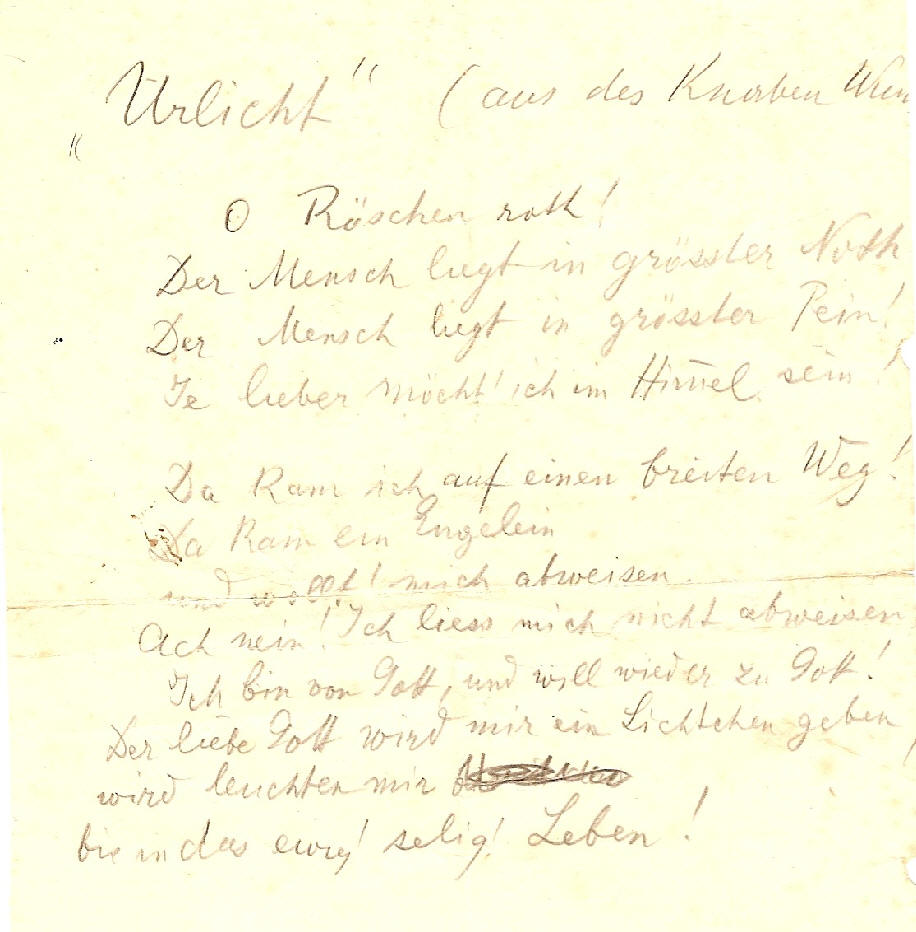Movement 1: Bedachtig-nicht eilen-recht gemachlich
Moderately, not rushed, Sonata form. Flutes and sleigh bells open the unusually restrained first movement (and used later with a melodic theme known commonly as the ‘bell theme’, which helps define sections throughout the movement) often described as possessing classical poise. As would be expected for the first movement of a symphony, the first movement […]
Lied 12: Es sungen drei Engel einen Sussen Gesang
Bimm Bamm. Es sungen drei Engel einnen Sussen Gesang (German: Armer Kinder Bettlerlied). “What the Angels Tell Me”. The text is loosely based on a 17th-century church hymn, which Paul Hindemithlater used in its original form in his Symphony “Mathis der Maler”) about the redemption of sins and comfort in belief. Here, a children’s choir imitating bells and […]
Lied 11: Urlicht

Also in Symphony No. 2 – Movement 4: “Urlicht”. Sehr feierlich, aber schlicht. Text Lied 11: Urlicht written in 1905 by Gustav Mahler for Hendrik (Han Henri) de Booy (1867-1964). Lied 11: Urlicht. Urlicht O Röschen rot! Der Mensch liegt in größter Not! Der Mensch liegt in größter Pein! Je lieber möcht’ ich im Himmel sein! Da kam […]
Lied 10: Lob des hohen Verstandes
Lob des hohen Verstandes is, like the Fischpredigt, a satirical song. It is of a jolly nature, describing a singing contest between the cuckoo and the nightingale. The judge of the contest is an ass. The ass of course declares the cuckoo the winner. The musical painting of the cuckoo’s call and the ass’s bray […]
Lied 9: Wo die schonen Trompeten blasen
Wo die schönen Trompetten blasen is another rather sad, but achingly beautiful song. This song combines elements of the military and the pastoral. The trumpet and horn calls are soft, however, and we are dealing with a meeting of two lovers before the man goes off to war. The horn call music contrasts with the […]
Lied 8: Lied des Verfolgten im Turm
Lied des Verfolgten im Turm is very similar to Der Schildwache Nachtlied, but now the protagonist is a prisoner. Again, the style is military. The burden of the song is the refrain that thoughts are free, despite the fact that he himself is not. Again, this is a dialogue song. The prisoner’s sweetheart speaks to […]
Lied 7: Rheinlegendchen
Rheinlegendchen is perhaps the most tender of the settings and, as many others of a pastoral nature, employs a 3/8 meter. It is quite lightly scored and very leisurely in pace. It describes the story of a girl who throws her ring into the sea hoping that her true love will find it. The ring […]
Lied 6: Des Antonius von Padua Fischpredigt
Des Antonius von Padua Fischpredigt, in 3/8 time, is best known as the source for the music of the scherzo of the Second Symphony. Its music employs strings and winds in perpetual motion as well as interjecting woodwind figures. The ironic text describes a saint who, on finding an empty church, goes to the water […]
Lied 5: Das irdische Leben
Das irdische Leben is a grim little piece, perhaps providing the negative counterpart to Das himmlische Leben, the song that became the finale of the Fourth Symphony. The music is of a decidedly eerie nature, employing divided strings in a quiet perpetual motion. Some of the string parts play pizzicato figures along with woodwind interjections […]
Lied 4: Wer hat dies Liedlein erdacht?
Wer hat dies Liedlein erdacht? is another pastoral setting and, as Verlorene Müh’; it is in 3/8 meter. It is a typical rustic scene involving admiration of an innkeeper’s daughter living on a hill. The song is reflexive however, and ends by asking the question of who came up with this little ditty. The outward […]
